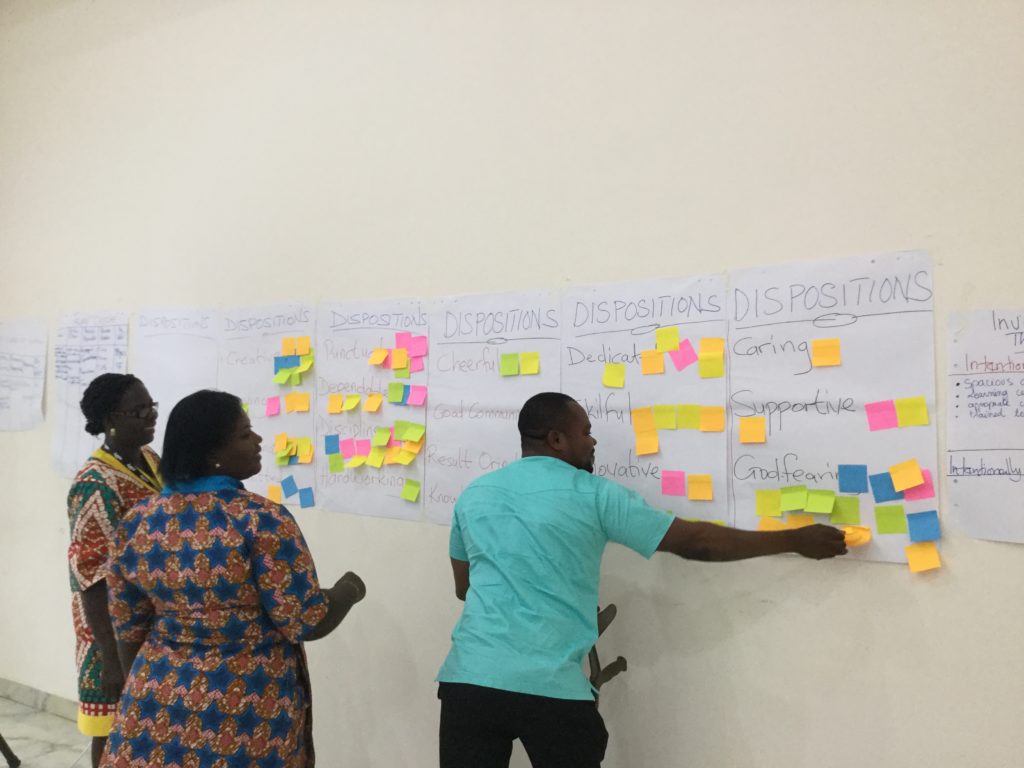By Dr Corinne Brion
University of Dayton
Few adequate educational leadership trainings are available for school leaders in Africa (Bush & Oduro, 2006). Due to the lack of professional development in leadership, the use of a Training of Trainers (TOT) model appears to an effective way to build the capacity of large numbers of school leaders. For the past few years, Dr. Paula Cordeiro and I have worked on a TOT model in Burkina Faso, Ghana, Liberia, Ethiopia and Rwanda. Here are the key lessons we learned from our experience with TOT.
Strengths of our TOT model:
Being Culturally Responsive to Ensure Sustainability
One of the strengths of this TOT model was that we spent many days in schools before developing the training materials. Hence, after numerous visits and many conversations with local school leaders, teachers and potential local trainers, our team designed modules grounded in the local needs. Based on cultural realities, the TOT model has evolved.
Keeping in Mind How Adults Learn Best
In order for the materials to be relevant to the participants and to enhance the transfer of knowledge, the materials were designed so that trainers do not lecture; instead, trainers become facilitators of learning. Often times in Africa, knowledge is delivered through lectures or a ‘stand and deliver’ approach in which the teacher or the professor speaks, and the students listen. Because trainers were themselves predominately taught through a lecture approach, they tended to teach that way as well. In the beginning of their training with us, they tended to revert to lecturing and asked and answered their own questions. The active pedagogy we used was at first foreign to both the trainees and the training participants. We had to explain, model and practice with the trainers and participants for them to understand the benefits of such active learning practices.
Script, Feedback and Follow up
We learned that not only did we have to teach the content of the materials to the future trainers, but we also had to teach them how to deliver the content. As a result, we created scripted Facilitator Guides. The detailed scripts outlined the time spent on each activity, the page number in the Participant Guide as well as how to approach each activity and what to say. Additional information in the script includes background information for particular concepts.
We also gave feedback to the trainers regularly. At the end of each training day, we held debriefing session in which we discussed the content, the participants, and each other’s training performance. This practice allowed for self-reflection and critique of each other’s teaching. The debriefing sessions also strengthened the working relationships and trust among all of us. Building trust was essential to be able to receive and give feedback. In addition to the debriefing sessions, we wrote feedback letters to all trainers
Relationships and Trust
Building strong relationships is fundamental to conducting effective work. In our TOT model, we built strong relationships by being culturally aware and competent and adapting to the foreign cultures, by observing and by asking questions and feedback on our materials and our approach. Trainers also had opportunities to build strong relationships with us and with their colleagues by co-teaching and by communicating by text messages regularly or through Skype. The use of mobile technology was an effective way to stay connected and answer questions from the USA. As one trainer said: “I know you are one of us, therefore I know I can come to you anytime.”
Invest in Quality
Typically, we trained two to three trainers at once since we believe that this approach yields high quality trainers. Training two or three trainers at a time over an extended period of time allowed us to ensure that the trainers understood and were familiar with the content as well as the approach. It also allowed us to build strong relationships. While this approach is costly initially, we believe that providing in depth training to a few trainers is a worthy investment because these qualified trainers will then train others without us being present.
In order to find experienced trainers, we decided to pay them well. Observers and trainers all receive stipends. Observers receive less than first time co-facilitators who receive less than the trainers. We also realized that most of our trainers work full time at other institutions, so we ensured that we ask their availability for trainings early in the school year.

Challenge
I will list one challenge here.
Language
There are always subtleties in language. I am originally from France, English is my second language. Paula is American and speaks Spanish. Our trainers in Africa not only speak French or English but also one or several local languages, and various dialects. Almost needless to say that in our work, we experienced many moments when communications, verbal or non-verbal were challenging!
We all had to learn a common language in order to move forward. The common language was the language used in the leadership modules. We modeled which language to use when giving feedback for example. Paula and I had to learn local words, expressions and gestures to communicate effectively. Here again, being open to feedback and being culturally proficient is helpful to adapt to the cultures and languages local use. The training modules have been translated in French for Burkina Faso and in Amharic for Ethiopia.
These are some of the lessons we learned, for more, please see: Brion, C., & Cordeiro, P. A. (2018). Lessons Learned from a Training of Trainers Model in Africa. Journal of Educational Leadership and Policy Studies, 2(1)).



















very good thanks